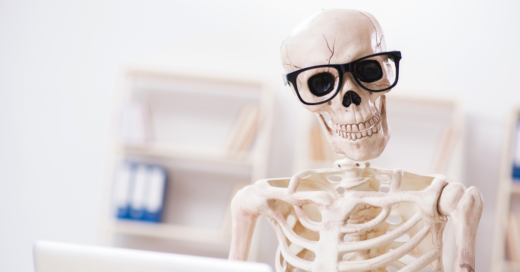
Halloween brings pumpkins, bats, ghouls and goblins. And we can’t forget the skeletons. Though often serving as a scary decoration or costume, skeletons are nothing to fear. Bones play a vital role in the human body, and there is no better time than the month of October to talk about bone health. The physicians of Gaston Medical Partners are here to break it all down for you (no pun intended).
Let’s Talk About Bones
Bones are living tissue made up of collagen and calcium phosphate. The adult human body contains 206 bones, which provide structure and serve to protect our organs. Ever wonder why it seems like children heal quicker from broken bones than adults? New bone replaces old bone at a faster rate during childhood and teenage years, contributing to your overall bone mass. Girls reach their peak bone mass earlier than boys, at age 18, with boys reaching it at age 20, although bone mass can keep growing through your late 20s. The higher your starting bone mass, the less likely you are to suffer from bone diseases, like osteopenia and osteoporosis.
Osteopenia vs. Osteoporosis
Bones become thinner as you age, and the condition osteopenia refers to bones that have weakened, but not to the point of breaking. If osteopenia does occur, it’s usually not until after age 50, and treatment can help prevent it from turning into the more severe bone disease, osteoporosis.
Over 53 million people in the United States have either already been diagnosed with osteoporosis or find themselves at an increased risk of it due to lower bone mass and deteriorated bone tissue. Both men and women can be affected by osteoporosis, but women are at a greater risk. It affects 25% of women ages 65 and up compared to 5% of men ages in the same age range. A diagnosis of osteoporosis may not be known until after someone breaks a bone, with the most common injuries occurring in the wrist, hip and spine.
Why Are Women More Likely to Get Osteoporosis?
Based on their overall size, women have less bone tissue than men. The hormonal changes that come in the first few years after menopause, due to lack of estrogen, also contribute to faster bone deterioration. Women of white and Asian backgrounds are at highest risk.
Can You Do Anything to Help Your Overall Bone Health?
There are several things that you can do to keep your bones strong and help ward off osteoporosis:
- Remain physically active with strength-building and weight-bearing exercises.
- Avoid tobacco use and excess alcohol.
- Review the medications you are taking to see if they can affect your bones.
- Know your family history, in case you are at increased risk.
- Make sure your diet contains enough calcium. The Recommended Dietary Allowance (RDA) is 1,000 milligrams (mg) of calcium a day, increasing to 1,200 mg a day for women over age 50 and men age over age 70. Calcium-rich foods include dairy products (milk, cheese, yogurt), leafy greens like spinach or kale, seeds, almonds, edamame and tofu, beans and lentils, and foods that may be fortified with calcium (think orange juice). Fun fact: Your bones and teeth contain 99% of your body’s total calcium, with the rest being in your blood.
- Your body needs vitamin D to absorb calcium. The RDA is 600 international units (IUs) a day, increasing to 800 IUs a day for adults age 71 and older. If you worry that you aren’t getting enough vitamin D from sunlight or food choices like fatty fish, eggs or foods fortified with it, you can get your levels checked and consider adding a supplement to your diet.
If you have any questions about your risk factors for osteoporosis or to find out if early screening is right for you, speak to your primary care doctor. Until then, be aware of the things you can begin doing to help keep your bones strong and healthy. And during Halloween season and all year long, remember there’s more to a skeleton than meets the eye.
